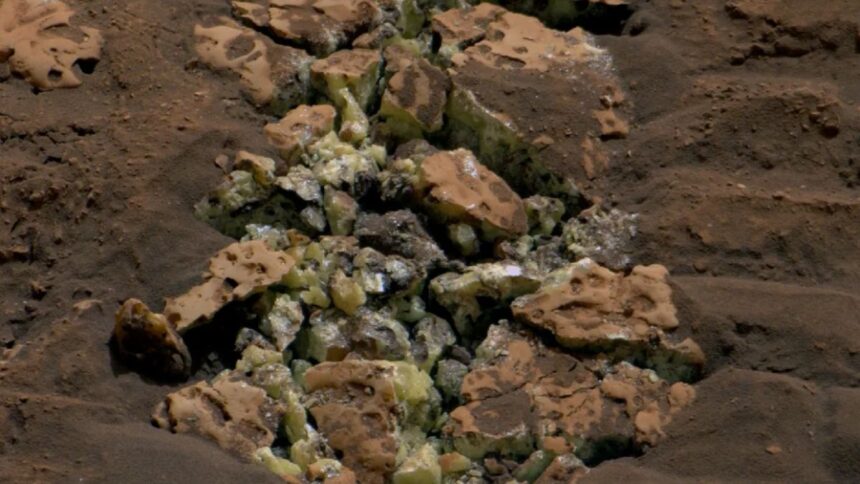NASA’s Curiosity rover has made another exciting discovery on Mars. While driving over a rock, the rover found pure sulfur. This finding was announced by NASA scientists on Tuesday. It adds to the growing evidence of Mars’s complex geological history.
The Discovery
The event happened when Curiosity was exploring a region near Mount Sharp. This is a central peak within the Gale Crater. The rover’s wheels crushed a rock, revealing a bright yellow material. Scientists used the rover’s instruments to analyze the substance. They confirmed it was pure sulfur.
Instruments Used
Curiosity is equipped with several advanced tools. These include the Chemistry and Camera tool (ChemCam) and the Alpha Particle X-Ray Spectrometer (APXS). These instruments help the rover examine the chemical composition of rocks and soil. The discovery of sulfur was a surprise. Dr. John Bridges, a planetary scientist at NASA, said, “We didn’t expect to find pure sulfur. This is an important discovery. It could change our understanding of the chemical processes on Mars.”
Why Sulfur is Important
Sulfur is a chemical element that is essential for life on Earth. It is found in hot springs, volcanic areas, and hydrothermal vents. These environments are rich in sulfur and can support various life forms. The presence of sulfur on Mars suggests that similar processes might have occurred there.
Possible Formation of Sulfur
There are several ways sulfur can form. On Earth, it often forms near volcanic activity. Volcanoes release sulfur gases when they erupt. These gases can settle and form pure sulfur deposits. Another way is through hydrothermal vents. These are cracks on the ocean floor where hot water and minerals spew out. If Mars had similar processes, it would mean the planet had volcanic activity and possibly water. Both are key to supporting life.
The Significance of Water
Water is essential for life as we know it. On Earth, wherever there is water, there is life. Scientists believe that ancient Mars had water. The Gale Crater, where Curiosity is exploring, might have been a lake. If water was present, life could have existed there.
Finding sulfur supports the idea of past water on Mars. Sulfur can dissolve in water. If Mars had water, sulfur could have been part of that environment. It might have been used by living organisms.
Curiosity’s Mission
Curiosity has been exploring Mars since 2012. Its mission is to search for signs of past life. It examines the geology and climate of Mars. The rover has made many important discoveries. It has found evidence of ancient rivers and lakes. It has also discovered organic molecules, which are the building blocks of life. Each discovery brings scientists closer to understanding Mars’s past.
Future Mars Missions
NASA plans to send more missions to Mars. The Perseverance rover is already there. It landed in 2021 and is exploring a different crater. It is also looking for signs of past life. NASA’s goal is to bring Martian samples back to Earth. Studying these samples in labs will provide more detailed information.
The Search for Life
Finding life on Mars would be a groundbreaking discovery. It would mean we are not alone in the universe. Even finding evidence of past life would be significant. It would show that life can exist in harsh environments. Scientists are looking for microbial life. These are tiny organisms that can live in extreme conditions. On Earth, microbes are found in hot springs, deep oceans, and icy regions. If Mars had similar environments, it might have had microbes.
The Role of Rovers
Rovers like Curiosity and Perseverance are essential to Mars exploration. They are equipped with advanced tools to analyze rocks and soil. They send data back to Earth for scientists to study. Each rover builds on the discoveries of the previous missions.
Challenges of Mars Exploration
Exploring Mars is not easy. The planet is millions of miles away. It takes months to travel there. Communication between Earth and Mars takes time. Rovers must be designed to survive harsh conditions. Mars has extreme temperatures and dust storms. Maintaining the rovers is also a challenge. Curiosity has been on Mars for over a decade. Its wheels show signs of wear and tear. Engineers on Earth work hard to keep the rover operational.
The discovery of pure sulfur by NASA’s Curiosity rover is a significant milestone. It adds to the evidence that Mars once had environments that could support life. Sulfur’s presence suggests volcanic activity and the possibility of water. These are crucial factors for life as we know it.
As Curiosity continues its mission, we can expect more exciting discoveries. Each finding brings us closer to answering the big question: Did life ever exist on Mars? For now, the search continues, and every piece of data helps us understand our neighboring planet better.
